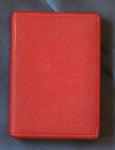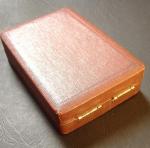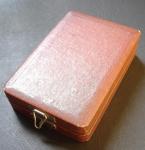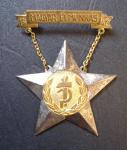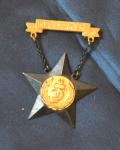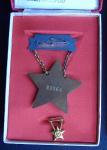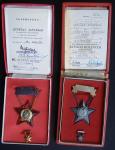-
Posts
2,660 -
Joined
-
Last visited
Content Type
Profiles
Forums
Blogs
Gallery
Events
Store
Everything posted by hunyadi
-

Hungary Hungarian Kivalo Dolgozol Badges
hunyadi replied to hunyadi's topic in Central & Eastern European States
Decker - that is a very rare first form of the Letter then number combination! Been looking for one of those! Very nice I have to ask - is this a 19-53 marked one. All of the 1953 marked ones (on the banner) dont seem to have numbers on them. Can you post the front? Gordon - as for numbers - only some of them have them - mostly only the early ones. Out of all of mine I only have 20% that have numbers on them. -

Hungary Hungarian People's Republic Awards
hunyadi replied to Ed_Haynes's topic in Central & Eastern European States
One source told me recently that there were 8000 partisan badges made. He of course didnt have hard proof, but he said that was the number. With more research and the numbers that keep showing up - its plausable. I think in the future we may see more of these in the higher numbers as it would go to suspect that the early numbers were awarded to 'early' partisans and threfore started dying off sooner. These things ahve just started showing up fairly regularly. It was a badge that I had considered rare, but within the last year...Anyhow - a year ago I was finding numbers in the 1000-4000 range and then just recently the 5000-6000 range is appearing. my only wish is that the prices would drop. As for cases, one feature that I find is the embossed frame around the rim of the lid as seen below. Most of the other awards that come in this shape of box seem to lack this detail. Also the Partisans always come in the red lined case - but so does the Heavy Industry Excellent Workers Badge. Anothr thing about the Partisan box is that the mini is always at the top and the badge at the bottom - most of the other cases for round badges have the mini at the bottom and hte badge at the top. The boxes also come sometimes with a latch - thougth I have now one without a latch. Still waiting to meet with my coleague to get in contact with the Partisan Association. (two weeks from now.) -

Hungary Hungarian "Death Squad" Arrow Cross Brassard
hunyadi replied to Mike's topic in Central & Eastern European States
found them... http://philosophy.elte.hu/~jhardi/kabsz/ -

Hungary Hungarian "Death Squad" Arrow Cross Brassard
hunyadi replied to Mike's topic in Central & Eastern European States
I have seen a photo - but I cant seem to find it recvently - this symbol was used by the death squads who were rounding up the individuals in civilian clothes - but also this symbol was that of a faction of the Arrow Cross party known (as I racall) the "Eastern Front Veterans Association" - a group comprised of veterans who had returned from service on the eastern front after 1942. They used this symbol and even had badges made (unofficialy) for wear on the uniform. I will continue to look for the photos. -

Hungary Hungarian People's Republic Awards
hunyadi replied to Ed_Haynes's topic in Central & Eastern European States
-

Hungary Hungarian People's Republic Awards
hunyadi replied to Ed_Haynes's topic in Central & Eastern European States
and the case - not the common style - the latch is not typical. The color of the case is also a deep red - not the bright red as seen on other cases. This color is seen on high end medals handed out by the government such as the Order of the Flag and Order of HUngarian Freedom. -

Hungary Hungarian People's Republic Awards
hunyadi replied to Ed_Haynes's topic in Central & Eastern European States
The reverse of the badges are also interesting as this is the first time I have seen the serial number engraved into the back of the miniature as well! I think this is may be a privatley purchased piece - or at least custom made case and engraving. -

Hungary Hungarian People's Republic Awards
hunyadi replied to Ed_Haynes's topic in Central & Eastern European States
A rather intersting boxed Partiszan badge - #6301. High number, but a very custom case. Not the typical version as one commonly sees for these - so of course I could not pass it up. THe interior has a nuce crush velvelt lining in deep red with recesses as pin holders for the pins so that even the miniature does not roll around loose in the case. -

Hungary Hungarian Kivalo Dolgozol Badges
hunyadi replied to hunyadi's topic in Central & Eastern European States
and the reverse - rather high serial number for such an early badge - perhaps 'restored' parts - or perhaps they used serial numbers for one year and then started over. Dont have enough examples to say for certian. The more I learn about these - something always gets throwin into the mix... -

Hungary Hungarian Kivalo Dolgozol Badges
hunyadi replied to hunyadi's topic in Central & Eastern European States
-

Hungary Hungarian Kivalo Dolgozol Badges
hunyadi replied to hunyadi's topic in Central & Eastern European States
the back - privately engraved numbers co-oridinating with the award documents. The uncased one is #1409 and mathces the number of the document. However - the other one has the document to #500 not #733. But for some reason this guy felt that he should have numbered Kivalo Dolgozol badges. Somewhere out there is #500 I am sure of it - porbably also with the award doc to #733.... -

Hungary Hungarian Kivalo Dolgozol Badges
hunyadi replied to hunyadi's topic in Central & Eastern European States
Got this in the TESCO bag bargain. "Buy it all for XXXX!" is what the guy said. To me it was a bag full of stuff I already had or didnt need. But the price was great for all that came in it so I caved in. Inside were two Kivalo Dolgozol boxes with documents to the smae man from 1968-1969. One of the boxes was nearly destroyed - the other was in not too good of shape either. Took them home and needed to clean the grime and such off of them - thats when I discovered....... -

New Air Force Award Unveiled
hunyadi replied to Lukasz Gaszewski's topic in United States of America
I remember my brother-in-law who was in Iraq in 2003-04. He said when the Air Force arrived at the base he was at - the Army sighed a big sigh as they knew it was now safe and there were to be no more mortar attacks. (truly after the winged boys showed up the mortar attacks went to zero...) -

Hungary Hungarian Kivalo Dolgozol Badges
hunyadi replied to hunyadi's topic in Central & Eastern European States
"Muszaki" is the Technical Engineer. So this one was given specificaly to those in an engineering field (mechanical, electrical, chemical, ect...) dont see this type too ofthen after the Rakosi period, but I have seen a few examples with the Kadar coat of arms. Also didnt know that Stakhanov was a miner - everyone I talked to here said he was a facotry worker - the legend evolved... -
A rough guess would be about $1000-1500 if you have a SS, PH, and Victory with documents. Could even go for more as WW1 PH are hard to get and desired by almost all of us. In reality it was a small number of individuals that actualy saw combat in WW1 - but those that did suffered fairly high casualty rates - the Marines particularly
-

Hungary Hungarian Kivalo Dolgozol Badges
hunyadi replied to hunyadi's topic in Central & Eastern European States
-

Hungary Hungarian Kivalo Dolgozol Badges
hunyadi replied to hunyadi's topic in Central & Eastern European States
the back of the Szakma is numbered - rather high! But it was the end of this 'Rakosi' era of available examples -

Hungary Hungarian Kivalo Dolgozol Badges
hunyadi replied to hunyadi's topic in Central & Eastern European States
and the two othe Kivalo Dolgozol badges - notice the one on the left. It is a Szakma Kivalo Dolgozol (machinist) this is the 'professional' grade of the badge - also notice the carrying document is from 1958... -

Hungary Hungarian Kivalo Dolgozol Badges
hunyadi posted a topic in Central & Eastern European States
After 200+ posts in the Hungarian thread, I thought that I would start a thread on the 1948-1989 HUPR era of the Excellent Workers Badge. This thread is going to limit it to the civilain form of which there were more than 300 variations. A breif history goses as such. In 1948 the first form of the "Kivalo Dolgozo" badge appeared. The badge was nearly always a banner with the titiel on it and then having two chains that hung a five pointed star in silver or silver plate. At the center of these was a badge / coat of arms that showed from which industry the awardee worked - some what like a trade unioin - but not. There were about 15 different varaitions of the center. The most commonly seen are the metal workers industry. (I have seen one for the Red Cross - but as these are so rare - I could not justify the price.) In 1953 the ramapant variation and titles on the banners was brought under the central control of the Council of Ministers. A standard from was adopeted whereby the central badge was to be only the HUPR coat of arms. The 'Rakosi' coat of arms was the central figure from 1953 to 1956 (but was awarded even into 1958!) After the 1956 revolution the central badge became that of the 'Kadar' coat of arms (1957-1989). The badge underwent several design revisions - namely in order to concerve material and by the 1980's the quality had degraded considerably. Workers of all wlaks of life could aquire the badge. Factory, Engineers, Doctors, Secratries, etc... could all receive the badge. Generaly the requirement for receiveing the badge was an increase in production 20-60%. With each profession, this was determined by the local party secratary who reviewed each case for approval. The badge also caried with it a monetary award - generaly about 1 months salary. The real prize was the "Sztahanavista" badge which was awarded between 1950 (+ or -) to 1956. The badge meant 'to be like Sztanahov' the fabled Soviet worker who increased his personal production by 400%. The requirement in Hungary was to increase production by 300%. The tragic part of it all is that in many cases the worker was expected to maintian the level of production! So with that all being said - I can say 'when it rains it pours'. Got this lot yesterday - the last day my friends shop will be open - thanks to the current government and rising rent Anyhow - meet "Piroska the Riveter" - this is a complete set from the family of a female Sztahanaviszta. She was awarded the highest badge in 1952 (with award book) the Sztahanaviszta is numbered 5768 and subsequently she went on to win three other Kivalo Dolgozol badges. (one for professional work in 1958! - she must have moved into a more 'trained' sector of the iron and steel facotry. Of interest (as I just said...) she worked for a company that manufactured seel and metal. The company later was bought out by none other than General Electric! -

Hungary Hungarian People's Republic Awards
hunyadi replied to Ed_Haynes's topic in Central & Eastern European States
It was my pleaseure to help! -

Hungary Hungarian People's Republic Awards
hunyadi replied to Ed_Haynes's topic in Central & Eastern European States
If memory serves right - they have a slightly differnet pin system and the enamel is the horrid cold enamel.... -

My Radio Interview about the Stolen Valor Act
hunyadi replied to emaier3's topic in United States of America
In seriousness and as a pun - you deserve a medal! -

Hungary Hungarian People's Republic Awards
hunyadi replied to Ed_Haynes's topic in Central & Eastern European States
IMHO - the badge is an early strike probably 1957 - 1960. THe case is a mid 60's at the earliest. Just a natural occurance where the badge sat in a bin awaiting a case for an porbably issued in the mid 60's to 1970's. Still a nice set. -

Hungary Hungarian People's Republic Awards
hunyadi replied to Ed_Haynes's topic in Central & Eastern European States
Not a problem - can you post a photo of the bottom of the box and the reverse of the badge. It can help to determine if this is an early example or not.



